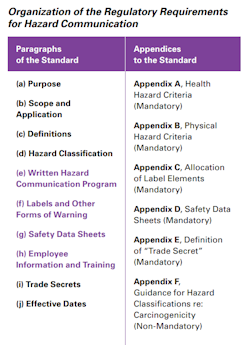The Hazard Communication Standard (HCS)
In order to understand the requirements of Hazard Communication Standard (HCS) as applied to your workplace, it is useful to have a general familiarity with the organization of the standard.
The standard is divided into regulatory paragraphs that describe requirements, which are further supplemented by appendices that contain specific details.
The HCS is a unique OSHA standard in a number of respects. It incorporates what is referred to as a downstream flow of information from chemical manufacturers, importers, and distributors, to employers using the products:
- Chemical manufacturers and importers must classify the hazards of the chemicals they produce or import, and prepare appropriate labels and safety data sheets (SDSs) to convey the hazards, as well as recommended protective measures.
- Chemical manufacturers, importers, and distributors must ensure that the containers of these hazardous chemicals are labeled when shipped, and that SDSs are provided downstream with the first shipment and when the SDSs are updated.
- Employers who use but do not manufacture or import chemicals are not responsible for making classifications or evaluating the hazards of a chemical. They must receive a label and SDS from suppliers based on the classification the suppliers have made.
Right to Understand
The HCS states that workers have the right to know and identify classified chemicals, it also gives workers the right to understand the hazards they pose. For example, if a chemical is a strong acid, it is not enough for an employee to know the chemical is an acid. The employer must ensure employees understand the hazards of a strong acid and how to protect themselves from the associated hazards.
Knowledge Check Choose the best answer for the question.
1-2. The HCS states that workers have the right to not only identify classified chemicals, but to ______.
You forgot to answer the question!

